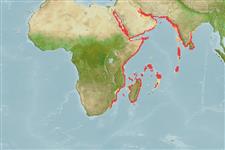>
Eupercaria/misc (Various families in series Eupercaria) >
Nemipteridae (Threadfin breams, Whiptail breams)
Etymology: Nemipterus: Greek, nema, -atos = filament + Greek, pteron = wing, fin (Ref. 45335).
Environment: milieu / climate zone / depth range / distribution range
Écologie
marin démersal; non migrateur; profondeur 20 - 450 m (Ref. 100719). Tropical; 31°N - 30°S, 31°E - 99°E (Ref. 3810)
Western Indian Ocean: including the east and west coast of India, Pakistan, Persian Gulf, Red Sea, Gulf of Aden, east African coast, Seychelles and Madagascar, east to Myanmar. A Lessepsian migrant (Ref. 84163). This species has been previously misidentified as Nemipterus mesoprion.
Length at first maturity / Taille / Poids / Âge
Maturity: Lm 15.6 range ? - ? cm
Max length : 27.0 cm TL mâle / non sexé; (Ref. 124816); common length : 15.0 cm SL mâle / non sexé; (Ref. 3810); poids max. publié: 330.00 g (Ref. 124816); âge max. reporté: 3.00 années (Ref. 96857)
Épines dorsales (Total): 10; Rayons mous dorsaux (Total): 9; Épines anales 3; Rayons mous anaux: 7. Suborbital spine absent. Preopercle with 3 transverse scale rows. Pectoral and pelvic fins very long, reaching to or just beyond level of origin of anal fin. A line drawn up from posterior edge of suborbital reaching the dorsal profile at about 3 to 7 scale rows before origin of dorsal fin. Upper lobe of caudal fin produced into a long trailing light red filament. Axillary scale present. Color: Body silvery pink. Peritoneum salmon-pink.
Benthic on sand or mud bottoms (Ref. 30573). No major fishery exists, but a large population is believed to occur in the Persian Gulf. Minimum depth reported taken from Ref. 127989.
Russell, B.C., 1990. FAO Species Catalogue. Vol. 12. Nemipterid fishes of the world. (Threadfin breams, whiptail breams, monocle breams, dwarf monocle breams, and coral breams). Family Nemipteridae. An annotated and illustrated catalogue of nemipterid species known to date. FAO Fish. Synop. 125(12):149p. Rome: FAO. (Ref. 3810)
Statut dans la liste rouge de l'IUCN (Ref. 130435)
Menace pour l'homme
Harmless
Utilisations par l'homme
Pêcheries: intérêt commercial mineur
Plus d'informations
RéférencesAquacultureProfil d'aquacultureSouchesGénétiqueElectrophoresesHéritabilitéPathologiesTraitementNutrientsMass conversion
CollaborateursImagesStamps, Coins Misc.SonsCiguateraVitesseType de nageSurface branchialeOtolithesCerveauxVision
Outils
Articles particuliers
Télécharger en XML
Sources Internet
Estimates based on models
Preferred temperature (Ref.
123201): 15.0635 - 24.7625, mean 21.42 °C (based on 148 cells).
Phylogenetic diversity index (Ref.
82804): PD
50 = 0.5000 [Uniqueness, from 0.5 = low to 2.0 = high].
Bayesian length-weight: a=0.01318 (0.01100 - 0.01580), b=2.95 (2.91 - 2.99), in cm total length, based on LWR estimates for this species (Ref.
93245).
Niveau trophique (Ref.
69278): 3.8 ±0.5 se; based on size and trophs of closest relatives
Résilience (Ref.
120179): Milieu, temps minimum de doublement de population : 1,4 à 4,4 années (K=0.83; tmax=3; tm=3.2 Fec=26,091).
Fishing Vulnerability (Ref.
59153): Moderate vulnerability (37 of 100).
Climate Vulnerability (Ref.
125649): Moderate vulnerability (38 of 100).
Nutrients (Ref.
124155): Calcium = 514 [115, 1,025] mg/100g; Iron = 1.47 [0.47, 4.01] mg/100g; Protein = 18 [16, 20] %; Omega3 = 0.338 [0.163, 0.767] g/100g; Selenium = 65.5 [24.9, 176.2] μg/100g; VitaminA = 7.37 [1.70, 39.77] μg/100g; Zinc = 0.811 [0.466, 2.772] mg/100g (wet weight);
